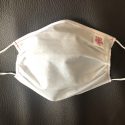Study shows virus abundant in COVID-19 cases in Wisconsin, even among fully vaccinated
Update, Aug. 13, 2021: Responding to interest in their original publication, the researchers who produced this study updated their preprint manuscript to include positive COVID test samples from more than 400 additional individuals, bringing the study’s total to 719 people who tested positive in Wisconsin from June 29 to July 31. They also joined with UW School of Veterinary Medicine virologist Yoshihiro Kawaoka’s lab to test a subset of samples with high levels of viral RNA, and found that nearly all contained infectious virus. Read the updated study in advance of peer review here on the preprint server medRxiv.
Some vaccinated people infected with COVID-19 in Wisconsin in June and July had just as much virus in their nasal passages as newly infected unvaccinated people, according to a new study published Saturday ahead of peer review on the preprint server medRxiv by researchers at the University of Wisconsin–Madison, Public Health Madison & Dane County and Exact Sciences.
The findings match a Centers for Disease Control and Prevention study released a day earlier describing an outbreak centered on a town in Massachusetts. Though they did not examine it directly in the study, the researchers say this suggests fully vaccinated people who get sick with COVID-19 could potentially infect others.
Analysis of nearly 300 COVID-positive samples collected in Wisconsin between June 28 and July 24 showed no significant difference in “viral load” between 79 fully vaccinated people and 212 unvaccinated people. Both the vaccinated and unvaccinated study subjects had high viral loads at the time of their positive tests — levels shown in previous studies to be substantial enough to make them contagious to others.
“This is what the CDC’s study showed last week in a single outbreak, but we are seeing the same in a more distributed sample across our state,” says Katarina Grande, co-author of the new study and public health supervisor and COVID-19 Data Team lead at PHMDC.
While only 50 of the samples underwent genetic testing to determine which strain of the SARS-CoV-2 virus was present, 42 of them (84 percent) were identified as the delta variant, a strain of the virus that now appears to be more transmissible. Nearly all new COVID-19 cases in Wisconsin involve the delta variant, including among vaccinated people. Nearly one-third of the study’s cases came from Dane County, home to the city of Madison and one of the nation’s highest vaccination rates.
However, in Dane County, unvaccinated people are being diagnosed with COVID-19 at a rate two-and-a-half times greater than vaccinated people. Some breakthrough infections are expected in vaccinated people since no vaccine is 100 percent effective.
Vaccination remains critical, the researchers say, since the available vaccines against the virus are effective, successful — even against the delta variant, according to recent research — and an important way for almost everyone to help prevent new, dangerous cases.
“They’re still working to keep people from becoming infected, though not necessarily as well as they were against earlier types of the virus,” says David O’Connor, a UW School of Medicine and Public Health professor, co-author of the new study and, with Thomas Friedrich, a scientist at UW–Madison’s AIDS Vaccine Research Laboratory, which has been collecting genetic samples from positive COVID tests since March of 2020. “As long as the vaccines are keeping people out of the hospitals, I would say they’re working spectacularly well.”
While the CDC study in Massachusetts focused on cases arising from a handful of large public gatherings, the new Wisconsin results came from more everyday circumstances.
“The predominant mode of transmission around here seems to be smaller gatherings and households,” says Friedrich, a study co-author and a professor in the UW School of Veterinary Medicine. “There’s nothing special about the particular circumstances, but we’re seeing vaccinated people can become infected. And when they do, they can pass the virus on to other people.”
The new results show that vaccinated people, who don’t have much to fear in terms of severe disease, must be mindful that they can still be a source of infection for others.
“If there are people in their lives who are vulnerable, they still need to take care to keep those people safe,” says Friedrich. “And so, we still need a community response to the pandemic that includes vaccinated people taking steps to prevent the unlikely — but not impossible — chance that they would transmit infection to others.”
As with the CDC at a national level, the findings in Wisconsin of high viral load even in vaccinated people led PHMDC to return to recommending face coverings indoors for vaccinated and unvaccinated people.
“Our understanding has really shifted in the last week,” Grande says. “We are always adjusting to emerging science, and delta is a different ballgame.”



